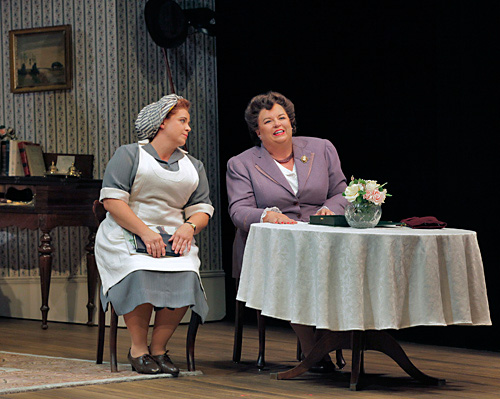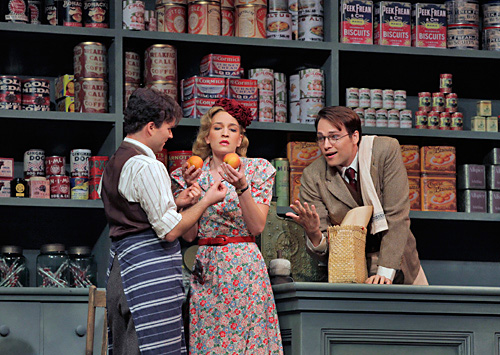|
In a period of less than a year and a half, the Steiny Road Poet has developed an ever-growing taste for the operas of Benjamin Britten. Washington National Opera's production of Peter Grimes in May 2009 initiated her appetite, followed by the Castleton Festival's productions of The Beggar's Opera in the summer of 2009 and The Turn of the Screw in July 2010.
After the success of the large-scale Peter Grimes, which premiered in 1945, Britten turned to chamber operas in order to deal with limited resources available after the devastation of World War II. In quick succession, he wrote and premiered The Rape of Lucretia (1946) with libretto by Ronald Duncan after the play Le Viol de Lucrèce by André Obey, Albert Herring (1947) with libretto by Eric Crozier after Guy de Maupassant's story Le rosier de Mme. Husson, and The Beggar's Opera (1948) an adaptation of John Gay's ballad opera with new harmonization's and arrangements of pre-existing tunes including additional dialogue written by Tyrone Gutherie. Later Britten added other chamber operas to his repertoire including The Turn of the Screw (1954) based on the novella by Henry James and Owen Wingrave (1971) an opera for television, after the short story by Henry James. Both of these later chamber operas had libretti by Myfanwy Piper.
ALBERT HERRING: A CHAMBER OPERA IN A BIG HOUSE
On August 4, 2010, the S.R. Poet attended the Santa Fe Opera's production of Albert Herring under the stage direction of Paul Curran and baton of maestro Sir Andrew Davis. What's interesting in particular about this fine production, which featured soprano Christine Brewer as Lady Billows (she is known for her remarkable portrayal of the title role in Richard Strauss's Ariadne auf Naxos) and the able newcomer, lyric tenor Alek Shrader, as the shy Albert Herring, is that it fit successfully in the large pavilion of SFO's Crosby Theater. Remember, Dear Reader, this was written as a chamber opera, meaning there is a limited number of singers on stage and players in the pit. However, like a full-scale opera, Albert Herring offers three acts and five scenes, with a run time of approximately two and a half hours.
 |
The story concerns a socially backward young man named Albert Herring who works in his family's grocery store. His widowed mother (played by mezzo-soprano Judith Christin) has him under her thumb. In the town where the Herrings live, Lady Billows has gathered together a group of town officials to find a girl worthy of being the May Queen. Lady Billows will put up a purse of 25 guineas to the lucky girl selected. The problem is that no girl can meet the standards set by her Ladyship and as reviewed by her housekeeper Florence Pike (played by mezzo-soprano Jill Grove). Therefore, the group decides to tap Albert as May King. Foremost the story is a coming of age tale and includes the charming courtship of the butcher's assistant Sid (played by baritone Joshua Hopkins) and Nancy (mezzo-soprano Kate Lindsey), the girl who works at the village bakery. The political landscape of this comedy deals with small town busybodies and small-minded ideals.
THE SERIOUSNESS OF BRITTEN'S COMEDY
In general, comedy is harder to render successfully than drama or tragedy because comedy with depth requires a balance of tragic and comic. While Albert Herring has many two-dimensional characters, Albert transforms by the end of the opera into a man of substance. He has his night out (and who knows what the drunken Albert does with the ladies in this production with whom he is seen leaving the family store), comes home after everyone thinks he has died, stands up to his "mum," and takes over management of the store. The lovebirds Sid and Nancy also flesh out as three-dimensional characters. The Steiny Road Poet was particularly drawn to costume designer Kevin Knight's choice of red hat, red belt, red shoes for Nancy's first appearance on stage. Of course, the idea was turn Albert's head but who could not notice how beautifully enticing Nancy was.
 |
Musically, Britten spoofs comic opera with passages that sound like the operettas of Gilbert and Sullivan. He allows the teacher Miss Wordsworth (played charmingly in the SFO production by soprano Celena Shafer) to sound an off-key pitch pipe as she leads her young students in a celebratory song for May King Albert. Britten also seems to poke fun at conventions like vocal ornamentation, but a serious side prevails in Britten's music making. He has modeled some passages after those of Richard Strauss. He quotes himself, particularly from Peter Grimes. Most importantly he creates ensemble singing that surpasses what has come before in 20th century music. For example, the May King sextet which is a fugue that ends Scene1 of Act I and the nine-voice lament ("In the midst of life is death" Act III), with throbbing ostinato. Unabashedly, Britten allows for a large universe of musical forms, including children's gaming songs.
THE VOCAL POWER VERSUS THE INTIMACY
While the orchestra for Albert Herring is comprised of only thirteen players, it is the multiple-voice ensembles that make this chamber opera viable for a large house like the Crosby Theater. Usually chamber operas have no chorus but Albert Herring is populated with a satisfying number of voice ensemble compositions that more than make up for this large-sound requirement of full-scale operas. Furthermore Paul Curran smartly selected the big-voice of Christine Brewer who is familiar with the music of Richard Strauss. That selection surely was a nod to overcoming any idea that Albert Herring was a work too small for the big stage at Santa Fe Opera.
Still Curran did not compromise the intimacy or innocence that Britten and Crozier created. Alek Shrader, who only made his professional debut a couple of years ago as Almaviva in Rossini's Barber of Seville with Opera Theatre of Saint Louis, was a perfect choice to sing the role of Albert Herring.
Another interesting detail of Curran's production of Herring is that he made Lady Billow's housekeeper Florence a layabout. When Act I opens, Florence is seen lounging on the sofa. She smokes a cigarette. In the background, Lady Billow's hollers at Florence to do various things. In other productions of Herring, Florence is depicted as a harried, hard worker but this raises the question, as the Steiny Road Poet's seatmate asked, "How would Florence have time to be such a busybody who knows the reputation of every girl in their village if she worked hard for Lady Billows?" One can imagine, since Curran advances the time of this opera from 1900 to the year Britten premiered the work in 1947, Florence talking on the telephone to other household staff to gather some of her local news and gossip.
Since the Steiny Road Poet had never been in the state of New Mexico before her venture out to the high desert campus of the Santa Fe Opera, she was initially aware of how large and protected the Crosby Theatre was, especially when nature punctuated the opening scenes of Albert Herring, with jagged bolts of lightning. However, Paul Curran, Sir Andrew Davis, and a very talented company of singers did an excellent job of creating the closeup-ness required of a chamber opera. Even the stagehands dressed in period costumes as they moved furniture and rolled up the grass contributed to that intimacy.
Photos - Ken Howard
|



